Space resilience and the importance of multiple orbitsby Matthew Mowthorpe
|
| For resilience and to meet the threat requirement it still requires sovereign GEO satellites at the core. |
The US Department of Defense is working on a feasibility concept of proliferated constellation of satellites in LEO for satellite communications. The idea of building large constellations of small and less expensive satellites to ensure a persistent service is of interest to the commercial market. A satellite communications service in GEO requires a relatively low number of satellites—on the order of less than five—for near-global coverage. Providing the same coverage with a LEO requires several hundred satellites.
OneWeb
OneWeb is deploying a constellation of 648 small satellites with a mass of around 150 kilograms. It is deployed in LEO with an altitude of 1,200 kilometers. The first prototype satellites were launched in February 2019, the deployment phase of the regular satellites commenced in February 2020 with the launch of the first 34 satellite. Initial operating capability for the service was in late 2021.
Starlink
Starlink is a subsidiary of SpaceX. The planned initial constellation will consist of up to 12,000 small satellites each with a mass of around 230 kilograms. They will be deployed in three orbital regimes in LEO. The first 1,500 satellites are planned in an orbit of 550 kilometers. The first prototype satellites were launched in May 2019.
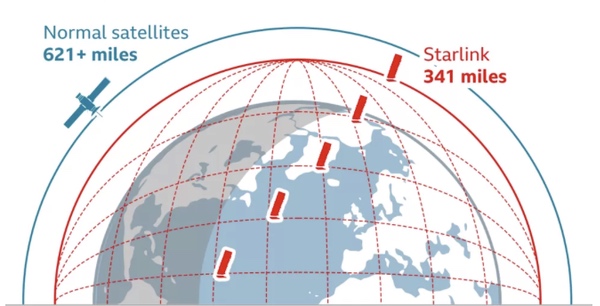 Starlink proliferated LEO communications satellites |
Chinese and Russian plans
The state-owned China Aerospace Science and Technology Corporation has planned to have a 300-satellite Hongyan LEO communications constellation. The state-owned China Aerospace Science and Industry Corporation plans its own 156-satellite Xingyun communications constellation.[1] In 2020 China made an application for 12,992 LEO broadband satellites. This was called GuoWang[2].
Russia has also aspirations for LEO constellations. Roscosmos, Russia’s space corporation, announced plans to build the 288-satellite Efir constellation to provide global broadband by 2025. This is part of larger project to build 600 communications and optical imagery satellites to provide global coverage in LEO.[3]
Optical intersatellite links
The most critical technology for realizing the potential for proliferated constellations in LEO for satellite communications resides in the link segment, and laser communications is fundamental. Space-based optical communications, or laser communications, is the key to forming the space mesh network.[4] This is critical to provide multiple, diversified connectivity paths to route information to and from space at the speed and scale to conduct all-domain operations. Laser communications is important to negate the increasing ability of adversaries to threaten communications networks. Optical inter-satellite links are vital for connectivity between satellites. It is also vital that optical communications terminals are integrated for terrestrial and airborne systems to enable data to be sent and received in an operational setting. This infrastructure would require the wider adoption of phased array antennas capable of handling the rapid and continuous satellite beam handovers to the operation of the LEO and MEO constellations. Flexible terminals capable of seamlessly roaming across different governmental and commercial networks would be required to span the orbital regimes and operate over different frequency bands, waveforms, and security levels.
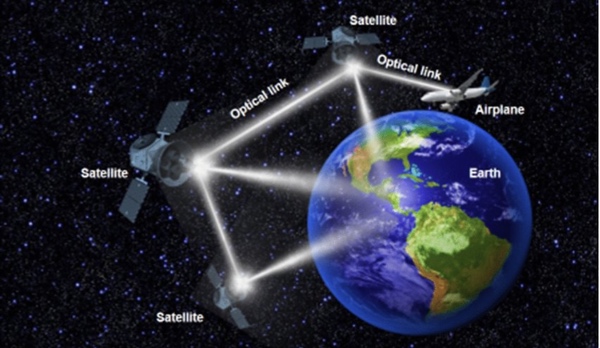 Optical inter-satellite links and satellite-to-ground communications |
Vulnerability of proliferated LEO communications
Lt. Gen. Stephen N. Whiting, commander of the US Space Force’s Space Operations Command, acknowledges the risks of LEO communications constellations that are networked not only with the receivers on the ground but also with each other. This connectivity means increased cyberattack surface. Each additional node added to a constellation creates links that add risk.[5] Cybersecurity is the soft underbelly of these global networks.
New LEO constellations make it more difficult because of the additional connectivity. Some GEO satellite communications operate on a simple bent-pipe principle: a user terminal points a single satellite, at a fixed position, and sends its signal back down to a ground station connected to a network. In a LEO constellation that features satellites that move swiftly relative to the users on the ground, the whole constellation needs to orchestrate connectivity. Satellites, user terminals, and ground control stations all need to be networked and controlled so that the satellites knows where to send the data it receives.[6] Multiplex connectivity is the source of the capabilities of a new LEO constellation, but its attack surface is broader, which means more entry points into the network for an adversary.
One way to mitigate this risk is the use of encryption. However if everything is going to be hardened then cost is going to increase. There is a delicate balance between cyber-hardening versus potentially accepting more risk to get data quicker. The nuclear command, control, and communications domain is risk-averse and the idea of accepting that risk is likely to be an anathema.
Nuclear hardening
There is no way to harden a satellite against a nuclear explosion that comes close to a satellite. The main effects of nuclear is the thermal pulse, followed by radiation and particle emissions. One way to counter this to distribute the satellite constellation in GEO so that one nuclear explosion could destroy no more than one satellite; of course, to achieve global coverage in LEO a large constellation would be required and they could not be dispersed. Satellites are usually thousands of kilometers apart, while the lethal range of a one-megaton explosion against a satellite with a feasible level of hardness is under 100 kilometers.[7] However, if the nuclear detonation is further away, the EMP effects can be overcome. High-altitude bursts generate an EMP that can couple into unprotected circuits and can cause burnout. Incorporating Faraday cage, filter, surge arrestor, waveguide cutoff, and fiber-optic technology in the ground site design can provide a level of protection against this threat.
| Multiplex connectivity is the source of the capabilities of a new LEO constellation, but its attack surface is broader, which means more entry points into the network for an adversary. |
To provide assured communications to support the nuclear command and control (C2) of strategic nuclear forces, protected satellite communications users need to be able to operate in a nuclear contested environment. The extra costs associated with provided this assured hardened capability means that it uneconomical to have a proliferated network of satellites in LEO to provide these strategic communications. The satellites providing nuclear C2 have traditionally been located in GEO and in smaller numbers than envisaged under the proliferated LEO communications concept.
The GEO belt, by its nature of being 36,000 kilometers away from the Earth, affords it a greater level of security from from adversary ASAT weapons, such as direct-ascent ASATs like as China’s operational DN-1 and Russia’s Nudol program that was successfully tested in November 2021. However, adversary nations do have kinetic ASAT programs, like as China’s DN-2, that could reach the GEO belt. However these ASAT missiles would take four to five hours to intercept. This advanced warning time could permit strategic communications valuable warning time to develop a defensive capability against such ASAT systems.[8]
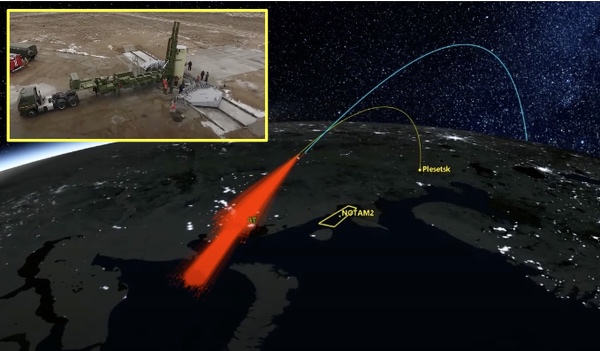 A Russian ASAT test on 15 November 2021. Nudol successfully intercepted Russian Cosmos 1408 orbit in blue using a direct-ascent Nudol kinetic weapon. The red depiction is the debris field depicted by AGI. |
Early warning satellites
China and Russia are developing multiple ASAT weapons to target current US space-based warning satellites, which are in predictable orbits. To address this space threat, a multi-orbit system of systems that can detect non-ballistic missiles from launch to their designated target areas is proposed. A multi-layered, space-based architecture in LEO, MEO, GEO and polar orbits[9] is recommended to not only detect missiles at all altitudes but also to provide fire control information in near-realtime. Resilience could be further enhanced by deploying satellites that are capable of enhanced maneuver to avoid ASATs; this capability tends towards smaller detection satellites in LEO. Additionally deploying decoys in LEO, MEO, and GEO would complicate an adversary’s attacks.
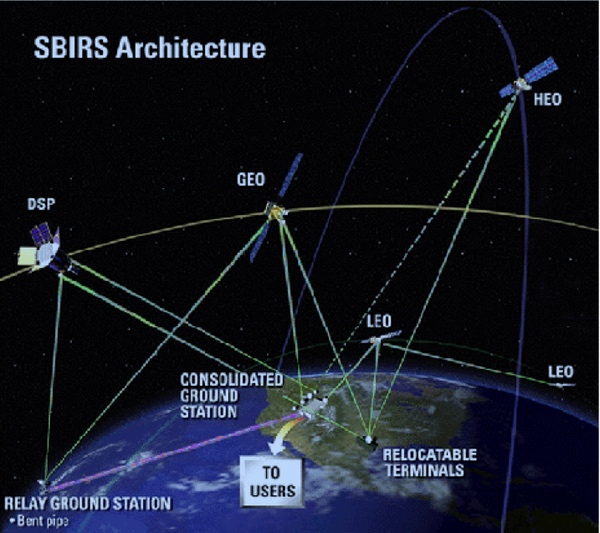 Space Based Infrared System Architecture |
The SBIRS architecture consists of five dedicated GEO and two host satellites in HEO. The constellation in these orbits provides a persistent stare over large geographic areas to detect missile launches. The advantages of GEO are readily apparent, but the relatively low number of satellites offers a target to adversarial nations. This has led to the concept of a mesh of sensors in a wider range of orbits, such as LEO and MEO, to provide a vital level of redundancy in a contested space arena.
Proliferated LEO Tracking Layer concept
The US Space Development Agency (SDA) was founded in 2019 with the task of rapidly launching hundreds of satellites for the National Defense Space Architecture. The first launch will be Tranche 0, expected in early 2023, with 28 satellites that will provide communications for US and allied forces. Tranche 1 consists of 126 satellites to be launched starting in 2024, with a further 18 experimental satellites to follow.[10] Tranche 1 is a network of small satellites in LEO to expand the ability to detect and track missiles, using low latency data connectivity. The SDA is planning to place constellations ib orbits of 1,000-1,200 kilometers because in orbits below 600 kilometers are becoming increasingly congested, placing satellites at risk from the increasing amount of space debris there. Final modelling for the constellation varies, with as few as three hundred to more than five hundred satellites potentially envisaged.
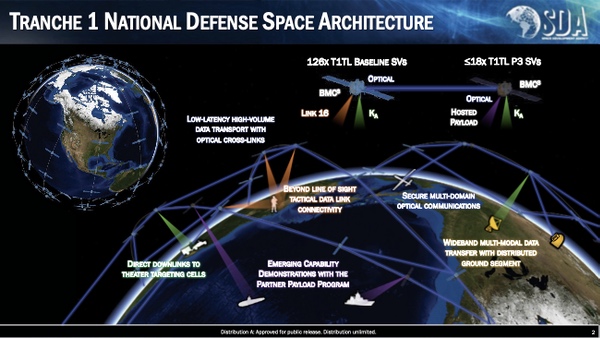 The Space Development Agency plan to establish the Tranche 1 Transport Layer, a mesh of 126 optical interconnected space vehicles to be launched in 2024 |
An advantage of a proliferated LEO, or p-LEO, constellation is the added resilience that tens and perhaps hundreds of satellites provides. This number presents to an adversary an overwhelming number of potential targets. While this may increase resiliency from kinetic threats such as the Russian NUDOL and Nivelir and China’s DN-1 direct ascent systems due to sheer numbers, the non-kinetic counterspace threats such as radio frequency jamming and high-power microwave weapons could affect multiple satellites in LEO, albeit for a limited amount of time.[11] Given the rapid growth in non-kinetic counterspace threats by adversarial nations, a resilient survivable missile warning architecture would have to include systems in MEO and GEO.
 Comparing fields of view in LEO, MEO, and GEO |
GEO-based satellites provide near-persistent stare for boost-phase missile detection, while providing simultaneous monitoring of specific theaters for shorter range ballistic missile detection.
| Given the rapid growth in non-kinetic counterspace threats by adversarial nations, a resilient survivable missile warning architecture would have to include systems in MEO and GEO. |
While proponents of each or the orbital regimes can highlight the strengths of the individual orbits, the resilience and advantage comes from a complementary set of orbital regimes. The multi-layered approach provides resiliency and survivability across the adversary’s spectrum of counterspace arsenal. Russia and China have threatened to destroy entire orbital regimes, particularly LEO, but to successfully prosecute a counterspace campaign against all three orbital regimes at the same time would be a significant challenge. Satellite operators would likely be able to fill gaps in coverage by those surviving systems if some are disabled in LEO and MEO.
Proliferated LEO satellites for intelligence, surveillance, and reconnaissance (ISR)
Large constellations of ISR satellites offer a high temporal revisit rate. However, large constellations of small satellites are presently limited in ground resolution due to the compact size of the satellites limiting the optics or the SAR sensors, either in size or in transmission power.[12] A large number of ISR satellites are harder to counter whether in terms of laser dazzling or jamming by an adversary in comparison to a lower number of higher capable systems in GEO.
Planet, a US-based company, already operates a constellation of over 200 small satellites, which offers medium resolution at 3–5 meters. Planet also has 13 SkySats, which are 100-kilogram satellites of sub-meter resolution. Planet’s satellites are sun-synchronous or other polar orbits. In November 2017, it achieved a major milestone of capturing the Earth’s landmass once per day.[13]
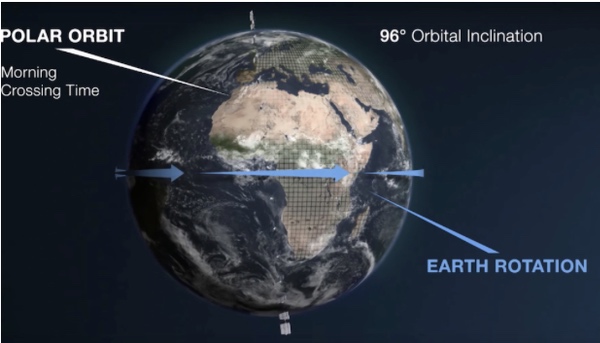 Planet constellation scanning the Earth |
GEO ISR assets
China has deployed a GAOFEN-4 imagery satellite in GEO orbit that is reportedly designed to track US carriers. That permits it to observe the Asia Pacific with near persistency.[14] China similarly has at least one satellite, the QIANSHAO-3 (QS-3) or Tongxin Jishu Shiyan Weixing satellite, that is a signals intelligence satellite in GEO. It is likely that China plans to expand both imaging and signals intelligence constellations. In 2017, QS-3 was the first of China’s satellites to carry a large mesh antenna with a diameter of 32 meters that is designed for signals ingelligence operations.[15]
A Russian satellite produced by ISS Reshetnev is intended to intercept signals from foreign communications satellites in GEO. Olymp/Luch was launched in September 2014 and has been travelling across the GEO belt near commercial communications satellites for periods ranging from several weeks to several months.[16] It was built for the Russian Ministry of Defence and the Russian intelligence agency FSB.
It is likely that the US uses the GEO belt to provide both EO and SIGINT capabilities for military users.
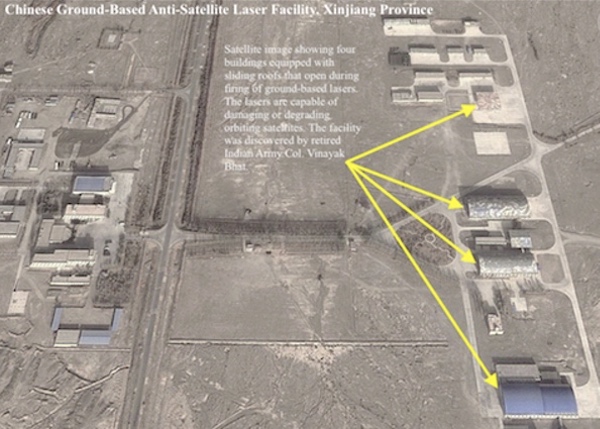 China’s ground-based laser ASAT at Xinjiang Province |
The use of the GEO belt for to provide ISR imagery for military users ensures that these assets cannot presently be targeted by ground-based laser directed energy weapon (LDEW) systems. China is actively pursuing LDEW for counterspace use and is likely to have an operational capability within the next five years, which could dazzle and potential damage a satellite’s imaging sensors in LEO. Russia similarly has been working on LDEW programs for dazzling and damaging imaging satellites in LEO. The GEO belt in the next five to ten years is likely to be outside of the technical capabilities of adversarial nation’s capabilities to interfere using LDEW against GEO ISR satellites. It would therefore be prudent to use GEO for ISR capabilities to augment any proliferated LEO constellation.
References
- Matthew A Hallex and Travis S Cottom, Proliferated Commercial Satellite Constellations, JFQ 97, 2020.
- Larry Press, Update on China SatNet’s GuoWang Broadband Constellation – Can They Do It? 3 February 2022.
- “Russia to Create Orbital Internet Satellite Cluster by 2025,” TASS, May 22, 2018.
- Gen Kevin P Chilton USAF ret. And Lukas Autenried, The Backbone of JADC2: Satellite Communications for the Information Age Warfare, Mitchell Institute, December 2021.
- Shaun Waterman, LEO Constellations Connectivity Offers Risks, and Rewards, Air and Space Forces Magazine Execs Warn, 7 April 2022.
- Ibid.
- Giffen, 77.
- See Matthew Mowthorpe, “The Russian space threat and a defense against it with guardian satellites”, The Space Review, 13 June 2022.
- Christopher Stone, Orbital Vigilance: The Need for Enhanced Space-Based Missile Warning and Tracking, Mitchell Institute Policy Paper, June 2022.
- US Space Development Agency Prepares for Launch, Aviation Week & Space Technology, 13 December 2021
- Stone, p.17.
- Lt. Col. Tim Vasen, Commercial Small Satellites in Low Earth Orbit, Joint Air and Space Power Conference, June 2020.
- Michael Baylor, “Planet Labs targets a search engine of the world”, Jan 2018, NASASpaceFlight.com./
- Lt.Col. Thomas R McCabe, Chinese Intelligence, Surveillance, and Reconnaissance Systems, 8 March 2021.
- GEO SIGINT- Qianshao/TJSW/Chang Cheng “Great Wall”, Global Security.
- Bart Hendrickx, “The status of Russia’s signals intelligence satellites”, 5 April 2021, The Space Review.
Note: we are using a new commenting system, which may require you to create a new account.
